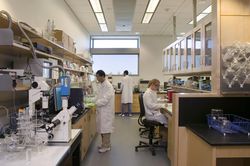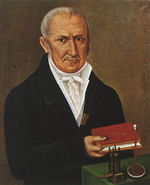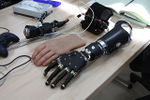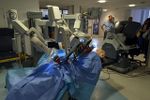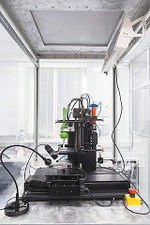Biomedical engineering
Biomedical engineering is the practice of combining engineering principles with medical sciences to design and create equipment, devices, computer systems, and software used in healthcare. The ultimate goal of biomedical engineers is to design instruments to better the lives of other humans by applying their engineering skills to biology. Also designing new techniques, this type of engineering tests new drug therapies. Not only does biomedical engineering help with techniques and new drug therapies, but also with the design of artificial organs. This field is not limited, biomedical engineering includes bioinstrumentation, biomaterials, biomechanics, clinical engineering, rehabilitation engineering, and also systems physiology. [1]
What biomedical engineering is
Biomedical engineering is the application of engineering principles to the health and biology fields. [2] Focusing on improving human life, biomedical engineering includes applying engineering science to the human health and performance. [3] Working alongside doctors, therapists, and researchers; biomedical engineering creates answers to problems any patient may face in life. [4] Those attracted to this field appreciate helping others in a mechanical method. [2] Biomedical engineering also requires those interested to create and develop new methods to better the lives of other human beings. [3] A diverse field, many students declaring their plan to study biomedical engineering have many fields to choose from, such as medical imaging and regenerative medicine. With many fields, many important, inventions from this study have changed the world. [5] Including the left ventricle assist device (LVAD), artificial joints, bioengineered skin, artificial limb replacements, robotic/laser surgery, implanted devices, and imaging methods.[4]
History
The first and oldest example of biomedical engineering was discovered in a mummy's tomb in Thebes, a pharaoh who lived in 3000 BC. Preserved nicely, researchers were able to identify that the toe was wooden and attached to the body with a piece of string. While this example of biomedical engineering occurred centuries ago, it is said that the nineteenth century holds the most productive era of biomedical engineering. In this specific century, the awareness of human life increased which caused many important inventions that helped to improve human life. [6] Leonardo da Vinci aided in the growth of the biomedical engineering field. Studying the human body extensively, da Vinci created many designs for the human body, but never actually created any, so, all of da Vinci's ideas were left ideas. Then in the 1800s, many inventions began to be made that helped the human life improve. [7] Luigi Galvani, an Italian philosopher, had a student named Alessandro Volta who invented the very first battery, which led, almost immediately, to the development of applying electricity to therapeutic purposes, such as the x-ray created by Wilhelm Roentgen. [8] While the nineteenth century was valuable to biomedical engineering, the twentieth century also contains many new and important biomedical engineering inventions. With Willem Kolff who conducted research and experiments on the kidney that led to the development in the late 1940's. Then Charles A. Hufnagel invented the first artificial heart valve, which soon was implanted in 1952. John H. Gibbon, a Philadelphia surgeon, performed the first successful human heart surgery with the assistance of a heart-lung machine in 1953. In 1958, the external cardiac pacemaker had finally been used successfully. Following these important inventions, universities began to develop biomedical departments. Some schools were: University of Virginia, Case Western Reserve University, Johns Hopkins University, and Duke University. All these universities still include biomedical engineering programs that have been conducting cutting-edge research on the topic.[9]
Otto Schmitt
Otto Herbert Schmitt was an influential biomedical engineer who is often called the father of biomedical engineering. Born in St. Louis, Missouri, in 1913, Schmitt began to show interest in electrical engineering but kept his mind open to other fields of engineering. With his talents, Schmitt applied to Washington University where he received his BA and PhD in three fields: physics, zoology, and mathematics. After receiving his degrees, Schmitt was hired by the University of Minnesota where he spent most of his time working. It was also here that Schmitt began to explore the undiscovered areas in the fields of biophysics and bioengineering. However, Schmitt's time at the University of Minnesota came to a halt during World War II, when Schmitt was required to carry out secret research for the US. Then the Cold War followed World War II, which allowed Schmitt to do defense-related research in New York.[10] Schmitt married his wife, Viola, and retired from the University of Minnesota in 1983, but his death followed on January 6, 1998.[11]
Otto Schmitt was described by some as eccentric and strange, due to the fact that he believed in the rule that all systems would eventually fail. This caused him to wear two watches on his hands and carry a third in his pocket to know that at least one would read the correct time. Believing this, Schmitt also carried around six to eight pens in his pocket just in case one died. Keeping his reputation of being strangely unique, Schmitt also thought that telekinesis and telepathy were real, and attempted to figure out how the mind worked until he died. However, his particular attitude allowed for him to create many new devices that have helped improve human life. Known for inventing the Schmitt Trigger, which is used in almost every computer input mechanism. This development allowed Schmitt to expand his realm of thinking and would soon create many devices relating to the biomedical engineering field. [11] Relating to the biomedical engineering world, Schmitt is also known for his help in the growth of biomedical engineering in schools. Holding the first large professional biomedical engineering meeting in Minneapolis in the year, 1958. Schmitt also was elected to the National Academy of Engineering in 1979, then in 1987, he received the Centennial Medal from the Institute of Electrical and Electronics Engineers (IEEE). [12]
Advancements in the field
The advancements of the biomedical engineering field have been important with the inventions of the many tools dealing with the diagnosis, therapy, and rehabilitation. Some examples of these inventions include artificial limbs, robotic surgery, and artificial organs.[13]
Artificial Limbs
- Main Article: Prosthetics
Artificial limbs, also known as prosthetics, hold a natural feel and look due to the advancements in electronics and other devices. Prosthetics now allow their user to climb rocks, stairs, swim, run, bike, and so much more all while working just as a natural limb would. Modern prosthetics may also give the user control of their fingers and even their sense of touch. Prosthetics are artificial limbs that are artificially made and distributed to those who have lost a limb. The placement of the prosthetic is also important, either above or below a major joint there are four places prosthetic mainly go. Below the elbow (BE, transradial), above the elbow (AE, transhumeral), below the knee (BK, transtibial), and above the knee (AK, transfemoral). These limbs are attached to the body through a socket, attached where the natural limb ends and works through the attachment mechanism and the control system. The use of prosthetics have dated back to 3000 BC but have grown in their uses and realistic abilities due to technological advancements.[14]
Robotic Surgery
A new, innovative design to face the invasive realm of surgery, biomedical engineering created robotic surgery. Robotic surgery enhances surgery through its precision, stability, and dexterity. These robots guide the needed instruments to the surgical site through image data and magnetic resonance. To do this, the robots require new algorithms and sensors to perform surgery on a patient. Once all these requirements are met, the robot can aid in performing minimally invasive surgery as well as enhance surgical performance in neurosurgery, orthopedics, and even cardiac surgery. In neurosurgery, an image-guided robot can perform a biopsy in a brain region without damaging surrounding tissue. In orthopedics, robots are utilized in shaping femurs as well as fitting prosthetic hips in place. Then, in cardiac surgery, robots are beginning to develop for performing closed-chest heart bypass, which is a surgical procedure where the heart continues to pump without needing to be placed on a heart-lung bypass. While robotic surgery presents its many positive there are certain things that prevent patients from leaning towards robotic surgery, such as high cost, unknown results, the safety of the patient, and the acceptance rate for any patient. [15]
Artificial Organs
Only 50 years ago the very first successful heart transplant took place. Now a new type of transplant has begun to enter hospitals, artificial organs. Studies have proven that scientist can actually grow organs in a lab with the use of stem cells. However the use of stem cells is controversial, so scientists discovered a new way to create organs, 3D bioprinting. 3D bioprinting is a new technique in which a scientist can make an organ. Relatively new, scientists have already made a thyroid gland, a tibia, that is implanted in a patient, and also a patch of heart cells that beat. All the organs are created in the 3D printer using bioink allowing for the job to make an organ. 3D printing is an innovative way to help with donor shortage, granting more people to receive their needed organ. The organ created in the 3D printer will replace the worn out organ in the patient's body providing them with another chance.[16]
Video
In this video, you will hear what a biomedical engineer is as well as see a new and unique project some biomedical engineers are working on.
References
- ↑ BiomedicalEngieers Bureau of Labor Statistics. Web. April 13, 2018. (Last modified). Unknown Author.
- ↑ 2.0 2.1 Whatisbiomedicalengineering Michigan Tech. Web. May 21, 2018 (Last accessed). Author unknown.
- ↑ 3.0 3.1 What is biomedical engineering Florida Institue of Technology. Web. May 21, 2018. (Last accessed). Author unknown.
- ↑ 4.0 4.1 Lucas, Jim. What is biomedical engineering? Live Science. Web. September 25, 2014. (Last modified).
- ↑ Biomedical Engineering UCDavise. Web. May 21, 2018. (Last accessed). Author unknown
- ↑ AHistoryOfBiomedicalEngineering Biomedical Engineering Guide. Web. May 21, 2018. (Last accessed). Author unknown.
- ↑ Neehar Banerjee. HistoryOfBiomedicalEngineeringEnglish Prezi. Web. January 17, 2013. (Last modified).
- ↑ Bioengineering Wiki. Web. January 9, 2015. (Last modified). Author unknown.
- ↑ History Navigate the Circuit. Web. May 21, 2018. (Last accessed). Author unknown.
- ↑ Harkness, Jon M.ALifetimeOfConnectionsOttoSchmitt ResearchGate. Web. January 2002. (Last modified).
- ↑ 11.0 11.1 Sullivan, Connie. OttoHSchmitt Como History. Web. May 21, 2018. (Last accessed).
- ↑ Patterson, Robert. OttoSchmittContributions IEEE Xplore. Web. November 13, 2009. (Last modified).
- ↑ Griffith, LG. AdvancesInBiomedicalEngineering PubMed. Web. February 7, 2001. (Date of publication)
- ↑ Woodford, Chris. [www.explainthatstuff.com/prosthetic-artificial-limbs.html Prosthetic_Limbs] Explain That Stuff. Web. February 19, 2018. (Last modified)
- ↑ Howe, Robert. RoboticsForSurgery Annual Review. Web. May 23, 2018. (Last modified)
- ↑ Galeon, Dom. ArtificialOrgans Futurism. Web. December 4, 2017. (Date of publication)
| ||||||||||||||||||||
